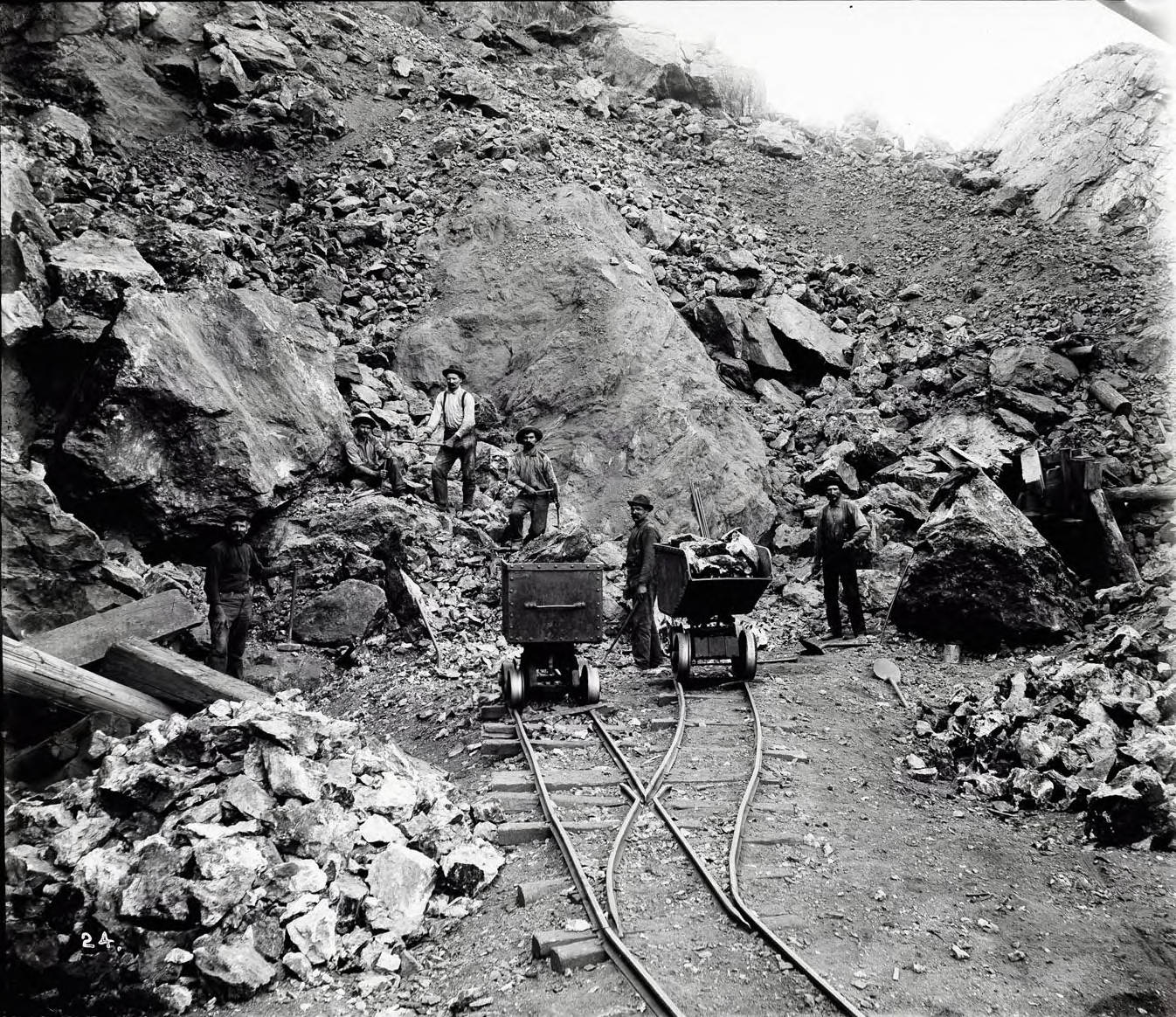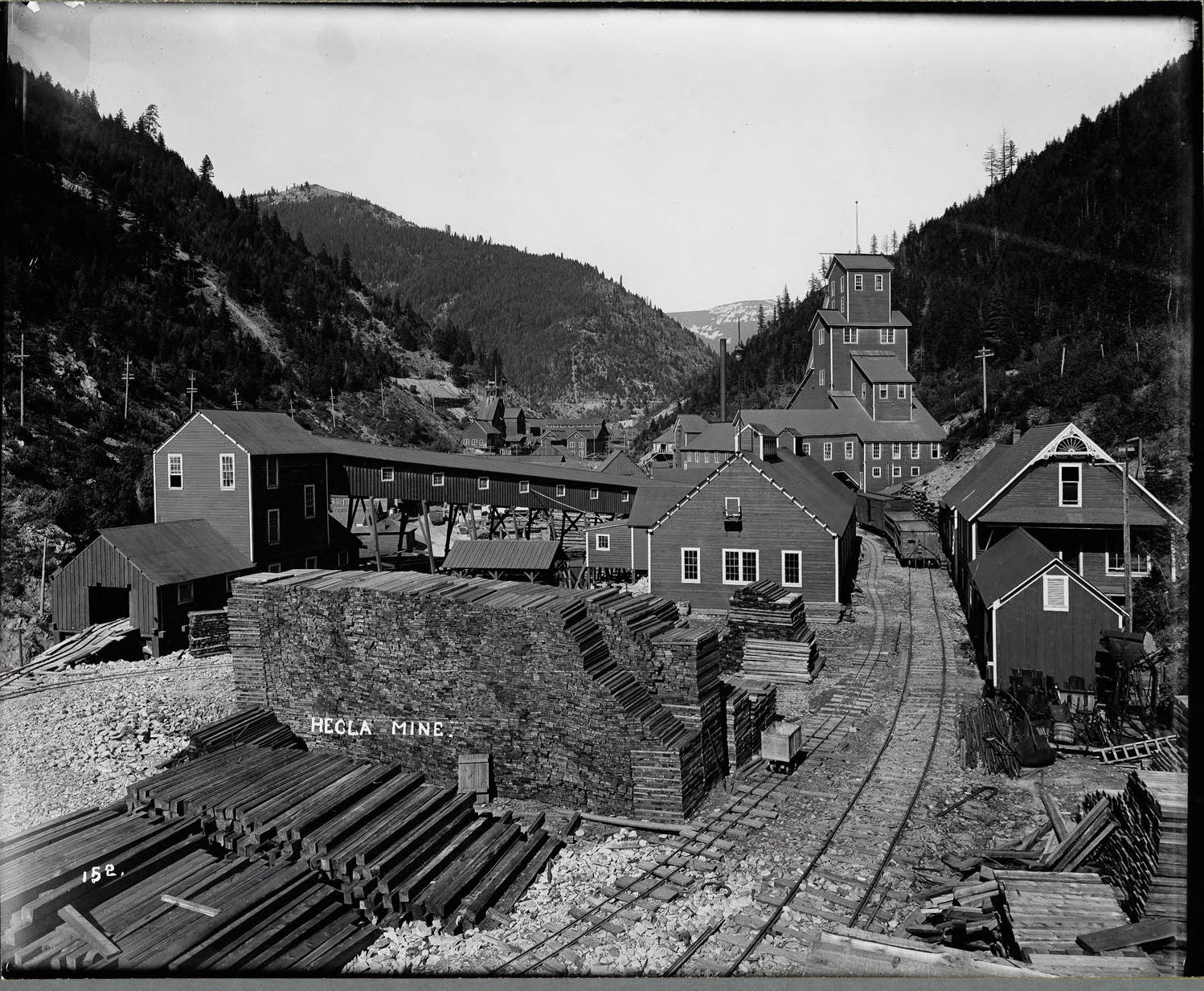Harry Webb Marsh Collection
Historic Mining Films from Idaho's Silver Valley Mining District
Contents: About the Collection | About Harry Webb Marsh | About the Coeur d'Alene Mining District | Tech
About the Collection
This collection contains historic mining films from Idaho’s Silver Valley Mining District and elsewhere, originally filmed by Harry Webb Marsh. These films were preserved thanks to a 2007 Partnership Grant from the National Film Preservation Foundation (NFPF) awarded to the University of Idaho Library’s Special Collections & Archives. Triage Archival Restoration Services in Los Angeles, CA conducted Preservation copying of the films.
The original moving pictures were filmed in 1926 and 1930 by Harry Webb Marsh, a mining engineer employed by the Tamarack and Custer Mining Company of Coeur d’Alene. Shot with one of the first private motion picture film cameras in Idaho, the films appear to be the earliest known footage of the Bunker Hill and Sullivan Smelter (1926), the Hercules and Hecla operations at Burke and Murray (1926), and the Coeur d’Alene Mines and the Little Sunshine Mine (1930). These films are held as part of the Harry Webb Marsh Collection (MG 23).1
About Harry Webb Marsh
To view other materials related to Harry Webb Marsh, see the Harry Webb Marsh Papers finding aid and contact Special Collections & Archives for more information.
Harry Webb Marsh was born in Moscow, Idaho on March 3, 1886. He was the first of three sons born to William and Mattie Marsh whose home was on the corner of First and B streets. He was educated in the Moscow City schools and the University of Idaho Preparatory School. After working for several years, he returned to the University of Idaho to study mining engineering.
In 1903, he made his first trip to the Coeur d’Alene mining area where he worked for a time at the Tiger Poorman Mine before returning to Moscow. His first job upon leaving, the university came in 1910 when he began working in the assay office of the Hercules Mining Company. He also helped on the design and construction of that company’s new concentrating plant. In 1912, he went to White Horse, Yukon Territory to manage the Atlas Mining Company, but due to low copper prices the mine shut down in 1913. He then went to Dawson, Yukon Territory, as an engineer with the Canadian Klondike Dredging Company, but at the beginning of World War I all the men in the area enlisted in the Canadian Army. He then went to Alaska where he was employed by the Alaska Treadwell Gold Mining Company on Douglas Island, and later by the Alaska Gastineau Gold Mining Company in Juneau.
He returned to the Coeur d’Alene in the fall of 1915 and joined the engineering staff of the Federal Mining and Smelting Company. In 1917, he began work for the Tamarack and Custer Mining Company where he remained until 1933. He continued to work for the Day family mining interests until 1941 when he was asked to go to Boise to assume the office of secretary-treasurer of the Idaho Mining Association, a position he held until his retirement in 1959. In 1949 President Harry S. Truman appointed him to the National Technical Task Committee on Industrial Wastes where he represented the entire non-ferrous metal mining industry.
From 1935 to 1941 he was in charged of the Shoshone County flood relief program. Working with the Army Corps of Engineers he supervised the construction of 28 Civilian Conservation Corps Camps to assist with this work. One of these camps, Camp F-30 in Pritchard, was renamed Camp Harry Marsh on July 16, 1933.
His other activities included serving as Shoshone County vice president of the North Idaho Chamber of Commerce for many years and as president of that organization in 1942. He also served as treasurer of the State Chamber of Commerce. He was a member of the American Institute of Mining Engineers and Petroleum Geologists, voted an Honorary Life Member of the Northwest Mining Association in 1953, and was a member of the Elks and many other clubs and organizations.
While working in Alaska in 1913 he met Lovina Willson whom he married in Seattle June 8, 1916. They had two children.2
About the Coeur d’Alene Mining District
Idaho has a rich mining history because it has a rich mineral makeup - “Idaho has seventy-two kinds of gem stones. This is more than any other state, and second only to Africa in the rest of the world.”3 This is why Idaho is nicknamed “The Gem State.”4 Industrial mining began in Idaho around the 1880s, although the Idaho gold rush began as early as the 1860s.
The Coeur d’Alene Mining District, located in the Silver Valley of Idaho, began as the George R. Marks & Company in the small “gold rush” town of Murray, Idaho. It was the first company in what would become the famous Coeur d’Alene Mining District.5
By 1884, the company was a large operation that spanned Murray, Burke, Mullan, Wardner, and Wallace. By 1914, the George Marks Company was renamed as the Coeur d’Alene Hardware Company and merged with Coeur d’Alene Iron Works, ultimately being named the Coeur d’Alene Hardware and Foundry Company.5
The company gained an international reputation for producing high-quality manufactured mining products that were distributed across the globe. By 1960, a final name change turned the company into the Coeur d’Alenes Company. The company continued to build strong relationships with various steel companies, particularly in Spokane, Washington and Boise, Idaho.6
Throughout its history, the Coeur d’Alene Mining District included many mines in the North Idaho region:
Burke Canyon Mines
- Gem of the Mountains
- Frisco Mine
- Mammoth Mine
- Standard Mine
- Hecla Mine
- Tiger-Poorman Mine
- Hercules Mine
Other mines in the district
- Bunker Hill Mine (1886)
- Star-Morning Mine (1887)
- Sunshine Mine (1890)
- Galena Mine (1922)
- Lucky Friday (1942)
By WWII, the Coeur d’Alene Mining District included 24 mines and 34 mills, the largest of which included the Bunker Hill and Hecla mines.7
Bunker Hill Mine
The Bunker Hill Mining Company began in the Coeur d’Alene Mining District as a small and humble operation but grew to be the largest mining-smelting company in Idaho and “one of the largest lead-zinc-silver properties in the world.”8 The mine contained “over 150 miles of tunnels, crosscuts and drifts extending from 3,600 feet above sea level to 2,000 feet below.” By 1980, the mine had produced “over 35 million tons of ore” after “93 years of continuous operation.”8
Hecla Mine
Another massive mine in the Coeur d’Alene Mining district was the Hecla Mining Company, a “major producer of silver in the United States.9 Hecla began in Burke, Idaho and was originally established as a silver mine. Hecla had produced “41 million ounces of silver before being shut down in 1944.” Eventually the company became involved “in the operation of a number of other base metal and uranium mines in the western United States and British Columbia” while still maintaining the reputation “as one of the most efficient underground mine operators in the world.” At its peak, Hecla employed 800 people and had 12,000 stockholders on the New York and Pacific Stock Exchanges.9
Sources
-
“Mining Films Preserved.” Idaho Harvester, September 1, 2014, https://harvester.lib.uidaho.edu/posts/2014/09/01/mining-films-preserved.html. (Archived: https://perma.cc/VZU8-VBW8) ↩
-
Judith Nielsen, “Harry Webb Marsh Papers, 1918-1966.” Archives West, 1989, https://archiveswest.orbiscascade.org/ark:/80444/xv58486. (Archived: https://perma.cc/VF37-JSVE) ↩
-
“Mining in Idaho.” Digital Atlas of Idaho, (Archived: https://perma.cc/33T4-4RQD) ↩
-
Hobart M. King, “Idaho Gemstone Mining.” Geology.com https://geology.com/gemstones/states/idaho.shtml. (Archived: https://perma.cc/22PX-MBJX) ↩
-
Jack G. Peterson and Susan E. Skog, Profiles: A Portrayal of Idaho’s Mining Industry (Boise: Idaho Mining Association, 198-), 4. ↩ ↩2
-
Jack G. Peterson and Susan E. Skog, Profiles: A Portrayal of Idaho’s Mining Industry (Boise: Idaho Mining Association, 198-), 4-5 ↩
-
John Fahey, Hecla: A Century of Western Mining, (Seattle: University of Washington Press, 1990). ↩
-
Jack G. Peterson and Susan E. Skog, Profiles: A Portrayal of Idaho’s Mining Industry (Boise: Idaho Mining Association, 198-), 6. ↩ ↩2
-
Jack G. Peterson and Susan E. Skog, Profiles: A Portrayal of Idaho’s Mining Industry (Boise: Idaho Mining Association, 198-), 8. ↩ ↩2
Technical Credits - CollectionBuilder
This digital collection is built with CollectionBuilder, an open source framework for creating digital collection and exhibit websites that is developed by faculty librarians at the University of Idaho Library following the Lib-Static methodology.
Using the CollectionBuilder-CSV template and the static website generator Jekyll, this project creates an engaging interface to explore driven by metadata.


